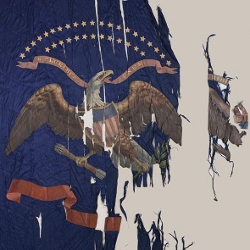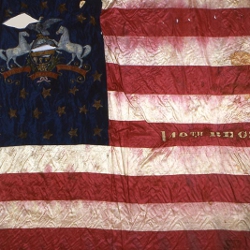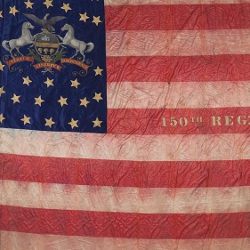 The Colors of the "Bucktail" Brigade
The Colors of the "Bucktail" Brigade 

On the afternoon of July 1, 1863, Colonel Roy Stone's "Bucktail Brigade" comprised of the 149th, and 150th PA Volunteers along with the 143rd PA, found themselves increasingly pressed by an onslaught of Confederate attacks, each one stronger until a massive push around 4 o'clock forced the brigade to retreat. The Confederate attack threatened to envelop the Federal lines and as the entire Federal first corps retreated, the men of the Bucktail brigade fell back slowly and in good order. Within the 143rd, Color Sergeant Benjamin Crippen turned toward the Confederate lines as the regiment fell back and defiantly shook his fist at the oncoming rebels. Crippen's open disdain for the enemy cost him his life and even Confederate Corp Commander A.P. Hill expressed sorrow at seeing the brave color-bearer fall. The 143rd lost all but two members of the color guard by days end.

The 149th and 150th fared little better than the 143rd in the ensuing retreat. The color guard of the 149th consisted of two color bearers and four guards. During the afternoon of the 1st of July the color guard, led by Sergeant Henry Brehm, was ordered to advance adjacent to the regiment, to draw Confederate artillery fire. Around 3:15 pm, Confederate infantry began approaching the position. Brehm however would not retreat without orders from Captain Bassler of Company C. Corporal Frederick Hoffman was dispatched from the guard to obtain fresh orders, but by the time he located the 149th and was granted permission to retreat, Confederate soldiers could be spotted between the regiment and its color guard. As members of the 42nd Mississippi approached the exposed color guard, they expected to see the entire 149th protecting the banners, but seeing no troops they immediately charge the colors. There was a desperate hand-to-hand struggle to seize the colors. Corporals Spayd and Lehman retreated with the regimental color, but saw nothing but the advancing line of J.M. Brockenbrough's troops. The two corporals tried to pass around the rebel brigade but the flag made them a high-profile target and both were quickly shot down. The regimental color was taken from underneath wounded corporal Spayd and its present location is unknown. Sergeant Brehm along with corporals Hammell and Friddell sprinted back towards their lines with the state color. Seeing a battle line in front of them half obscured with smoke, they were on top of it before they realized that the line was the rear of advancing Confederate troops. The three men bolted through the line and kept on running, but Hammell was shot in the stomach, and Friddell quickly received a horrendous chest wound. Brehm made it through the line unscathed only to be quickly hit in the back by a shell fragment and knocked down. The flag was quickly recovered by Private John Lumpkin of the 55th Virginia. The flag was returned to the state collection in 1905. Apparently it was recaptured on July 14, 1863 by the 6th Michigan cavalry when they attacked Lee's rearguard at Falling Waters, Maryland.

The flag of the 150th perhaps has the most interesting story related to the first day at Gettysburg. Withdrawing with the other regiments of the brigade, Color-Sergeant Samuel Peiffer was shot dead while carrying the state color. The sole surviving member of the guard, Corporal Joseph Gutelius seized the banner but was quickly wounded. Stopping to rest on a doorstep of a house in Gettysburg, Gutelius was shot and killed and credit for seizing the flag was given to Lieutenant F. M. Harney of the 14th North Carolina. Soon after, Harney was mortally wounded and his dying request was that the captured color be presented in his name to President Jefferson Davis. Davis accepted the color from North Carolina Governor Zebulon Vance. Even as Davis left the fallen city of Richmond in 1865 the flag remained with him. It was found in his baggage when he was captured near Milledgeville, GA in May of 1865. It was included in the war department's collections and given back to Pennsylvania in 1869 at the urging of former Secretary of War Simon Cameron.